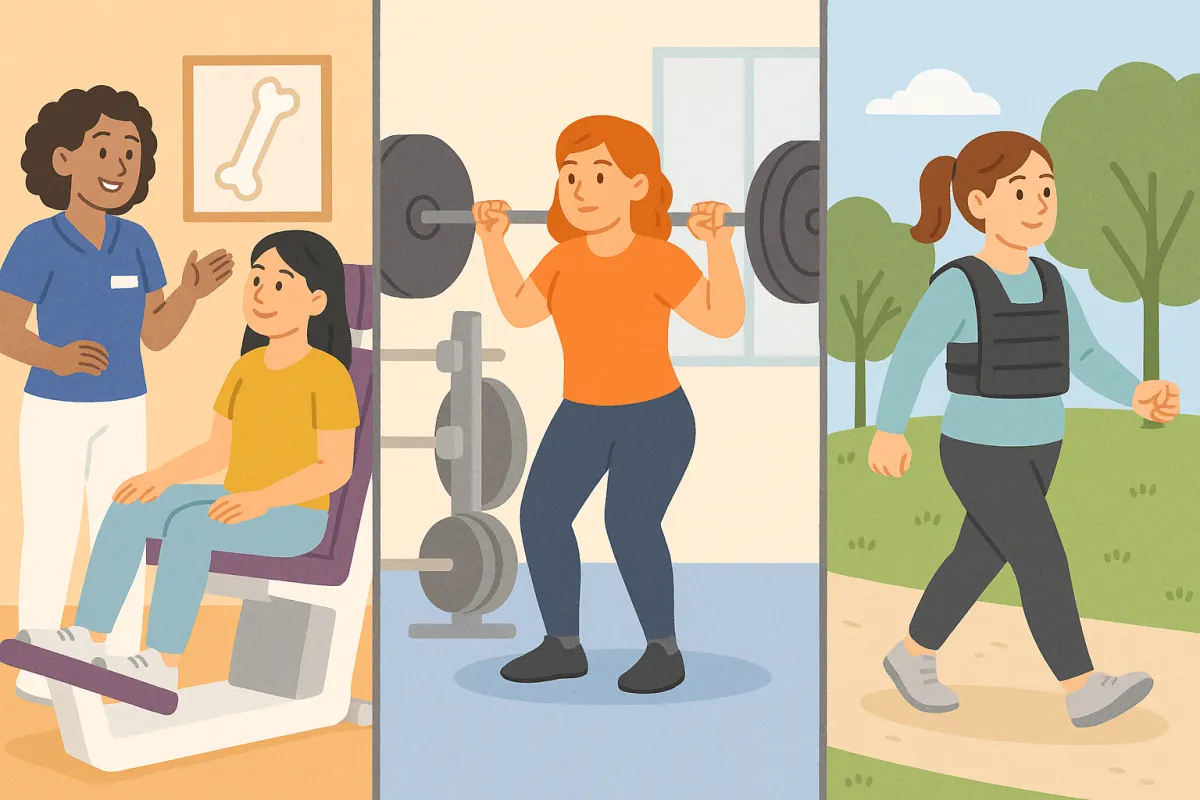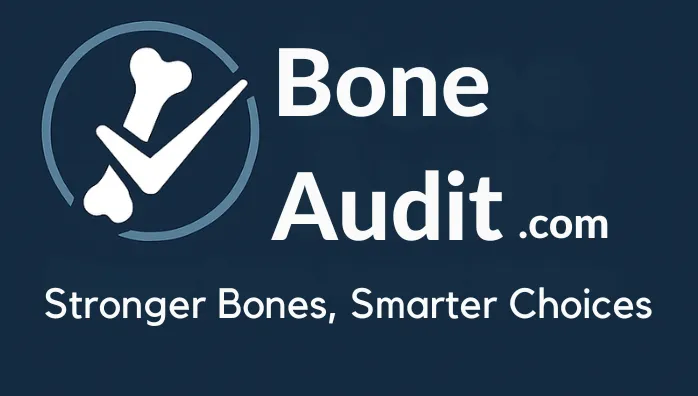
What Kind of Exercise Do I Need to Support My Bones?
If you've been told to “just exercise more” to help your bones, you're not alone — and you're probably still confused.
The truth is: not all exercise improves bone density.
In fact, only two types of exercise have been shown in published research to actually increase bone mineral density (BMD) — and most others help in other ways (like balance, strength, or general health), but don’t directly build stronger bones.
This guide breaks down the most common forms of exercise and explains which ones actually help your bones — and how.
✅ 1. Osteogenic Loading (High-Impact Without the Impact)
This is a type of exercise designed to safely apply very high force to the skeleton — enough to signal your body to build more bone.
It’s based on Wolff’s Law, which says bones adapt to the loads placed on them. But here’s the catch:
Research suggests you need forces above 4.2 times your body weight (4.2 MOB) to stimulate bone growth in the hip and femur.¹
That level of force is nearly impossible to reach through traditional workouts — but it can be achieved safely through several modern methods designed specifically for osteogenic loading:
✅ Common Osteogenic Loading Systems:
BioDensity® – The first commercial system designed to deliver high-force isometric loading. It's available through many medical clinics and rehab centers around the world.
🌐 biodensity.comOsteoStrong® – A global network of wellness centers originally built around BioDensity but later developed their own proprietary machines tailored to osteogenic loading and fast turnaround sessions.
🌐 osteostrong.meViiiv Fitness® – The newest player in the space. Their portable equipment is inspired by BioDensity-style loading but is designed to be more accessible and affordable for personal or clinic use.
🌐 viiivfitness.comOther emerging systems – A few startups and researchers are exploring home-based or wearable high-load tools, but as of now, the above three are the most established and accessible options.
These systems are non-invasive, supervised, and joint-safe, making them especially effective for older adults.
Most programs involve just one session per week, lasting about 10–15 minutes, and typically include pre- and post-loading work on vibration platforms to help with muscle activation and recovery.
➡️ Read more about Osteogenic Loading
✅ 2. HiRIT (Heavy Strength + Power Training)
HiRIT stands for High‑Intensity Resistance and Impact Training. It involves traditional strength-training movements (like squats, deadlifts, and overhead press) — but done with close supervision, proper technique, and specific loading targets.
It’s most commonly associated with:
The Onero™ Program, developed by researchers in Australia
The LIFTMOR Study, which showed that this type of training led to an improvement in spinal bone density, and helped maintain hip BMD — which is still considered a win, especially post-menopause.²
These results were achieved through:
Heavy lifting (80–85% of 1RM)
Supervised technique
Drop landings (gentle jumping)
2–3 sessions per week, each lasting about 30–45 minutes
💡 What is 1RM?
1RM stands for one-repetition maximum — the most weight you can lift for a single rep with good form.
Lifting at 80–85% of your 1RM means lifting heavy enough to challenge the bone, but still safe and repeatable for multiple reps.
➡️ Read more about HiRIT & Onero
🟡 3. Weight-Bearing Exercises (Better Than Sitting, But Not Bone-Building)
Weight-bearing exercises involve moving your body against gravity while on your feet. They include a wide range of activities, such as:
Brisk walking or hiking
Dancing or step aerobics
Elliptical or stair climbing
Jogging or running
Conventional weight lifting (without a specific protocol)
Bodyweight movements like lunges or squats
These activities are better than being sedentary and can help with:
Slowing bone loss
Improving balance, strength, and posture
Supporting cardiovascular and metabolic health
But here’s the key:
👉 Most don’t consistently deliver enough mechanical load to stimulate your body to build new bone, especially at vulnerable sites like the spine or hip.
They are supportive, but not bone-building on their own.
What About Running or Weight Lifting?
Running adds more impact than walking, but the risk of falls or fractures in older adults often outweighs the benefit — unless you have strong joints and no history of fractures.
Similarly, traditional weight lifting can be effective if you use the right intensity and progression — but without proper supervision or structure (like HiRIT), it’s often done too lightly to stimulate bone.
Pro Tip:
To maximise benefits and reduce risk, we recommend doing any weight-bearing or resistance-based activity under the guidance of a trained professional familiar with osteoporosis.
They can help design a program that’s both safe and optimally challenging.
Bonus Tip: A weighted vest can boost the challenge during walking or bodyweight movements — but still won’t match the force needed to rebuild bone density.
⚠️ 4. Walking (Helpful, But Not Enough)
Walking is often the first thing people are told to do when diagnosed with low bone density. It’s safe, easy to start, and has general health benefits like improving circulation, mood, and mobility.
But here’s what most people don’t realise:
👉 Walking does not increase bone mineral density.
There’s no strong scientific evidence that walking — even long distances — provides enough skeletal load to stimulate new bone growth.
It may help slow bone loss, especially in those who are sedentary, but it’s not a bone-building intervention.
Bonus Tip: Wearing a weighted vest while walking can increase muscle engagement and improve posture — and it may help with fall prevention — but it still doesn’t apply the force needed to build stronger bones.
ℹ️ 5. Other Exercises: Pilates, Yoga & Balance Work
Pilates and yoga are fantastic for building core strength, flexibility, and balance — all of which are crucial for reducing fall risk and improving posture.
They’re especially helpful for people who feel unsteady or stiff and want to move with more confidence.
But when it comes to building bone?
👉 These forms of exercise don’t deliver the mechanical load needed to stimulate bone formation.
They work well as supportive tools, but they are not substitutes for targeted high-load programs like osteogenic loading or HiRIT.
Bottom line:
If you love yoga or Pilates, keep doing them — but pair them with a bone-focused intervention if your goal is to improve BMD.
🚫 6. Unloading Exercises: Swimming & Cycling
Swimming and cycling are both fantastic for cardiovascular health, endurance, and joint-friendly movement. Many people enjoy them for staying active without strain — and they absolutely have a place in a healthy lifestyle.
But when it comes to your bones?
👉 These are considered “unloading” exercises — meaning they don’t provide the vertical force or impact needed to stimulate bone growth.
That doesn’t make them bad. In fact, they’re often excellent for:
People with joint pain or arthritis
Improving lung and heart health
Overall mobility and stamina
However, here’s something most people don’t know:
Many elite and master-level cyclists have been diagnosed with osteopenia — not due to poor fitness, but because cycling simply doesn’t challenge the bones enough to maintain density.
So while swimming and cycling are valuable for general health, they shouldn’t be your only forms of exercise if your goal is to protect or improve bone density.
Final Thought
If you're trying to build bone, not just maintain it, you need more than movement — you need the right kind of mechanical stimulus.
The two approaches with the strongest research behind them are:
Osteogenic Loading (e.g. OsteoStrong, BioDensity, Viiiv)
HiRIT-style training (e.g. Onero™)
So Which One Should You Choose?
The best program for you is the one you can stick to consistently. Some people enjoy structured strength training. Others prefer shorter, low-effort formats. Here’s a simple comparison table to help you decide:

Both Osteogenic Loading and HiRIT offer clinically supported ways to stimulate bone — safely and effectively.
If weight lifting appeals to you, that’s great — just make sure you're progressing with proper guidance. Without the right loading and technique, you may miss the mark or increase your injury risk.
Choose what fits your life — and stay consistent. Bone building takes time, but the right kind of exercise can make it possible.
Reference
Jaquish, J. et al. (2014). Minimum Effective Strain to Initiate Bone Density Adaptation. Journal of Osteoporosis and Physical Activity.
Watson, S. L., Weeks, B. K., Weis, L. J., Harding, A. T., Horan, S. A., & Beck, B. R. (2015). High-intensity exercise may reverse bone loss in women aged 65–75 with low bone mass: the LIFTMOR trial. Journal of Bone and Mineral Research, 30(1), 35–44.
